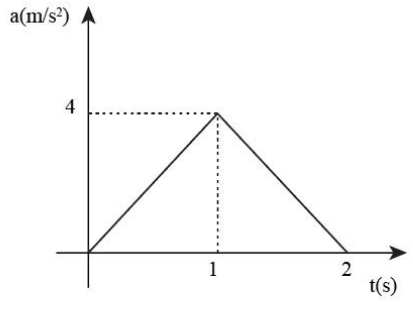
The acceleration time graph of a particle moving in a straight line is as shown in figure. The velocity of the particle at time \[t = 0\] is \[2\;{\rm{m/s}}\]. The velocity after \[2\;{\rm{s}}\] will be

A. \[6\;{\rm{m/s}}\]
B. \[4\;{\rm{m/s}}\]
C. \[2\;{\rm{m/s}}\]
D. \[8\;{\rm{m/s}}\]

Answer
557.1k+ views
Hint:The above problem is resolved by using the kinematic equation of motion. Moreover, the first kinematic equation of motion is used to resolve the problem. In the first kinematic equation of motion, the variables like the magnitude of initial velocity, the time interval, and the magnitude of acceleration can be identified by analysing the velocity-time graph. And by analysing this graph, the values are obtained. After obtaining the values, the substitution is made for the values to the mathematical equation of motion, and then the final answer is obtained.
Complete step by step answer:
Given:
The velocity at \[t = 0\] is, \[u = 2\;{\rm{m/s}}\].
The time interval is, \[t = 2\;{\rm{s}}\].
In order to find the velocity after 2 seconds, We need to find the area of the graph.
As, base represents the time and height represents the magnitude of acceleration \[a = 4\;{\rm{m/}}{{\rm{s}}^{\rm{2}}}\].
Then the area of the acceleration time graph is,
\[
v = 2 \times \left( {\dfrac{1}{2} \times t \times a} \right)\\
\Rightarrow v = 2 \times \left( {\dfrac{1}{2} \times 2\;{\rm{s}} \times 4\;{\rm{m/}}{{\rm{s}}^{\rm{2}}}} \right)\\
\therefore v = 8\;{\rm{m/s}}
\]
Therefore, the velocity after 2 seconds is \[8\;{\rm{m/s}}\] and option (D) is correct.
Note: To resolve the given problem, the concepts and applications of the kinematic equations of motion need to be taken under consideration and the various practical applications of the equations. While applying the kinematic equations of motion, one must always remember the increase or decrease of the variables' values. This is important because the sign conventions are decided by the increment and decrement of these variables' magnitude.
Complete step by step answer:
Given:
The velocity at \[t = 0\] is, \[u = 2\;{\rm{m/s}}\].
The time interval is, \[t = 2\;{\rm{s}}\].
In order to find the velocity after 2 seconds, We need to find the area of the graph.
As, base represents the time and height represents the magnitude of acceleration \[a = 4\;{\rm{m/}}{{\rm{s}}^{\rm{2}}}\].
Then the area of the acceleration time graph is,
\[
v = 2 \times \left( {\dfrac{1}{2} \times t \times a} \right)\\
\Rightarrow v = 2 \times \left( {\dfrac{1}{2} \times 2\;{\rm{s}} \times 4\;{\rm{m/}}{{\rm{s}}^{\rm{2}}}} \right)\\
\therefore v = 8\;{\rm{m/s}}
\]
Therefore, the velocity after 2 seconds is \[8\;{\rm{m/s}}\] and option (D) is correct.
Note: To resolve the given problem, the concepts and applications of the kinematic equations of motion need to be taken under consideration and the various practical applications of the equations. While applying the kinematic equations of motion, one must always remember the increase or decrease of the variables' values. This is important because the sign conventions are decided by the increment and decrement of these variables' magnitude.
Recently Updated Pages
Why is there a time difference of about 5 hours between class 10 social science CBSE

In cricket, what is a "pink ball" primarily used for?

In cricket, what is the "new ball" phase?

In cricket, what is a "death over"?

What is the "Powerplay" in T20 cricket?

In cricket, what is a "super over"?

Trending doubts
The camels hump is made of which tissues a Skeletal class 11 biology CBSE

Discuss the various forms of bacteria class 11 biology CBSE

Define cubit handspan armlength and footspan class 11 physics CBSE

Draw a diagram of nephron and explain its structur class 11 biology CBSE

The percentage of free SO3 in oleum sample which is class 11 chemistry CBSE

Write the differences between monocot plants and dicot class 11 biology CBSE




